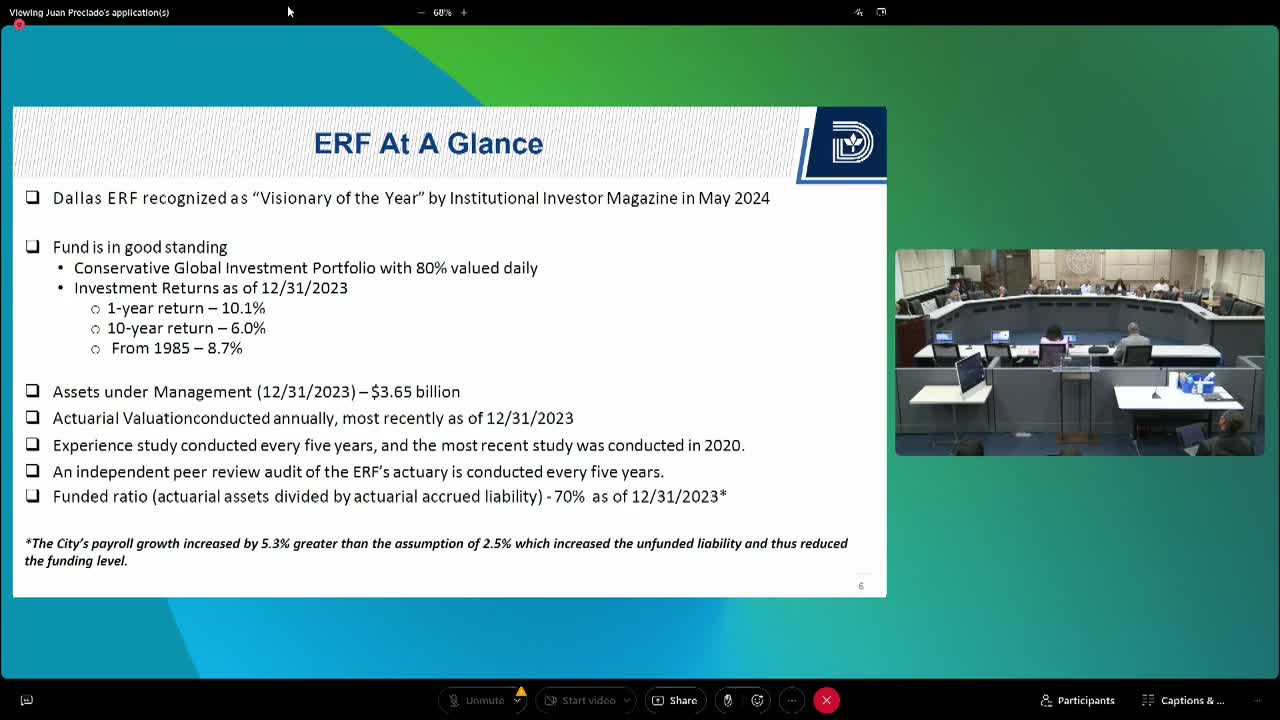City faces pension funding crisis as payroll growth surges
June 06, 2024 | Dallas, Dallas County, Texas

This article was created by AI summarizing key points discussed. AI makes mistakes, so for full details and context, please refer to the video of the full meeting. Please report any errors so we can fix them. Report an error »

During a recent government meeting, city officials discussed significant changes to the city's employee retirement fund, highlighting a 5.3% increase in payroll growth that exceeded the anticipated 2.5%. This unexpected rise has contributed to an increase in unfunded liabilities, subsequently reducing the overall funding level of the retirement system.
The meeting revealed that the city currently supports over 7,000 civilian employees and nearly 7,900 retirees, with an average annual benefit payout of approximately $42,000 for retirees. In 2023, the city disbursed $327 million to cover benefits for retirees and their beneficiaries. Officials noted that there are currently 900 employees eligible for retirement, which could impose an immediate financial burden of around $12 million if they all retired simultaneously.
The discussion also touched on the demographic profile of city employees, with the oldest active employee born in 1939 and the youngest in 2005. The oldest retiree was born in 1922, while the oldest disabled retiree is 91 years old and has been in that status for 58 years.
City officials emphasized the importance of maintaining a healthy balance between active employees and retirees, as a higher number of active employees contributes positively to the retirement fund. However, they noted that the city’s civilian workforce has not rebounded to its peak of over 8,300 employees in 2008, which has implications for contributions to the retirement fund.
The meeting also addressed the need for adjustments to the retirement plan, particularly regarding the Tier B benefits for new hires. Changes made in 2017 aimed to reduce benefits by nearly 39% for new employees, while still ensuring a sustainable retirement system. The city is on track to achieve projected savings of $2.15 billion from these adjustments.
Looking ahead, officials outlined a plan to comply with Texas government code requirements, which mandate that retirement plans must not exceed a 30-year funding period. Failure to meet this deadline could result in increased costs of approximately $150 million over the next decade. The city is working to finalize a funding plan before the September 2025 deadline.
In a key recommendation, officials proposed removing a long-standing 36% cap on contributions to the retirement fund, which has been in place for nearly 20 years. This change aims to increase the contribution rate for Tier A employees from 13.32% to 14%, thereby enhancing the fund's financial stability.
The meeting concluded with a commitment to draft necessary changes to the city’s retirement plan, which will be presented for voter approval in the November 2024 ballot. If approved, these changes could take effect as early as January 2025, ensuring the long-term viability of the city's employee retirement fund.
The meeting revealed that the city currently supports over 7,000 civilian employees and nearly 7,900 retirees, with an average annual benefit payout of approximately $42,000 for retirees. In 2023, the city disbursed $327 million to cover benefits for retirees and their beneficiaries. Officials noted that there are currently 900 employees eligible for retirement, which could impose an immediate financial burden of around $12 million if they all retired simultaneously.
The discussion also touched on the demographic profile of city employees, with the oldest active employee born in 1939 and the youngest in 2005. The oldest retiree was born in 1922, while the oldest disabled retiree is 91 years old and has been in that status for 58 years.
City officials emphasized the importance of maintaining a healthy balance between active employees and retirees, as a higher number of active employees contributes positively to the retirement fund. However, they noted that the city’s civilian workforce has not rebounded to its peak of over 8,300 employees in 2008, which has implications for contributions to the retirement fund.
The meeting also addressed the need for adjustments to the retirement plan, particularly regarding the Tier B benefits for new hires. Changes made in 2017 aimed to reduce benefits by nearly 39% for new employees, while still ensuring a sustainable retirement system. The city is on track to achieve projected savings of $2.15 billion from these adjustments.
Looking ahead, officials outlined a plan to comply with Texas government code requirements, which mandate that retirement plans must not exceed a 30-year funding period. Failure to meet this deadline could result in increased costs of approximately $150 million over the next decade. The city is working to finalize a funding plan before the September 2025 deadline.
In a key recommendation, officials proposed removing a long-standing 36% cap on contributions to the retirement fund, which has been in place for nearly 20 years. This change aims to increase the contribution rate for Tier A employees from 13.32% to 14%, thereby enhancing the fund's financial stability.
The meeting concluded with a commitment to draft necessary changes to the city’s retirement plan, which will be presented for voter approval in the November 2024 ballot. If approved, these changes could take effect as early as January 2025, ensuring the long-term viability of the city's employee retirement fund.
View full meeting
This article is based on a recent meeting—watch the full video and explore the complete transcript for deeper insights into the discussion.
View full meeting
